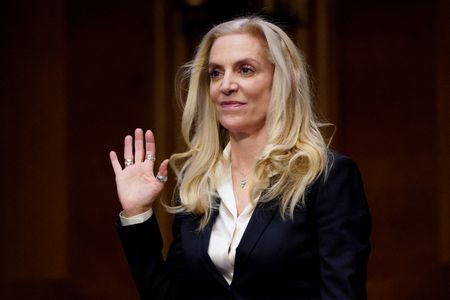By Howard Schneider and Andrea Shalal
WASHINGTON (Reuters) -In nearly a decade at the Federal Reserve, Lael Brainard argued for stricter financial regulations, traveled deeply in less-advantaged communities to explore how U.S. monetary policy affected them and, with subtle twists of language or analysis, more than once shifted the monetary policy debate.
The Fed’s vice chair since last May, Brainard is considered one of the more effective Democratic insiders in Washington and will now carry a career’s experience and a deep set of international contacts to her new role as director of the National Economic Council in President Joe Biden’s White House.
Biden named her to the job Tuesday, and the Fed in a press release said Brainard had submitted her resignation and would leave the central bank “on or around” Feb. 20.
Fed chair Jerome Powell in the press release said she had “brought formidable talent and superb results to everything she has done at the Federal Reserve,” and noted her work at the central bank had started in 2014 when the Fed was still firming up the financial system from an earlier crisis, and run through the “immense operational agency challenges” posed by the COVID-19 pandemic.
The move leaves the Fed’s No. 2 role vacant just as the central bank approaches a decision about when to stop raising interest rates.
Though Brainard, 61, has been full-throated in supporting the Fed’s aggressive rate increases so far, voting in favor of each one and endorsing the need to “stay the course” in lowering high inflation, she also in recent months began introducing reasons for caution.
Brainard has argued against ascribing too much importance to rising wages as a source of inflation, countering one argument used in favor of potentially higher interest rates. She has pointed to high business profit margins as an inflation source that could fall fast – an issue Fed Chair Jerome Powell has tended to avoid – and emphasized other ways rising prices might be tamed without a serious impact on employment.
Brainard’s arguments may not have been relevant to the decisions the Fed faces in the next few weeks. The central bank is broadly expected to approve quarter-percentage-point rate increases in March and May, and Brainard herself, in a speech last month, indicated she did not yet feel the Fed’s policy interest rate was “sufficiently restrictive” to tackle inflation.
But debate may get more pointed by this summer over whether to stop raising rates and allow more time for inflation to cool as the impact of monetary policy is felt, or move ahead with further rises in borrowing costs meant to put more pressure on the economy and potentially increase joblessness.
Heidi Shierholz, president of the labor-affiliated Economic Policy Institute, said it was “unbelievably important” that Biden find someone to fill Brainard’s role.
“She was just an incredibly important voice for good policy at the Fed and restraint and patience, given that we know that inflation is coming down,” Shierholz said. “If they do overshoot and cause a recession, the risks are much worse than the risk of not doing that.”
KEY VACANCY
Biden is expected to announce Brainard as the next NEC director later on Tuesday, giving her a top voice in U.S. economic policy for the second half of his current term and potentially positioning her for a major cabinet or other post if he wins reelection in 2024. Jared Bernstein, a long-time Biden adviser, is poised to be named the new chair of the Council of Economic Advisers.
Brainard’s new job would not require Senate confirmation, allowing her to change positions quickly.
The Fed’s next policy meeting is on March 21-22.
Administration officials gave no immediate sense of how soon Biden may name a new Fed vice chair, though outside analysts and commentators were already putting names in circulation from what’s considered a deep bench of economists affiliated with Biden’s Democratic party.
Open positions on the Fed Board of Governors can linger. Biden was in office for more than a year before filling three vacancies on the seven-member board, spreading among the four sitting governors a workload that includes not just monetary policy but bank supervision, financial regulation, the payments system, participation in several international bodies, and oversight of a sprawling apparatus that includes a large Washington-based staff and 12 regional banks.
The vice chair plays a particularly important role, typically reserved for somebody with a PhD in economics who can speak with technical authority about Fed policy and decisions.
But the Fed has, at times, gotten along without. When then-Vice Chair Stanley Fischer resigned in October 2017, it was 11 months before Richard Clarida was appointed, confirmed by the Senate, and sworn in to succeed him.
That would represent a massive gap in the current environment, when Fed policy is trying to adapt fast to data, and officials are trying to understand the direction of the economy after two years in which they underestimated the rise of inflation and several months in which they have been surprised by the continued strength of the job market.
Upcoming decisions on whether to continue raising the target interest rate, pause, or eventually cut it, would benefit from a vice chair able to settle quickly into the job, analysts said.
“Losing Brainard … at this moment means some loss of dovish influence on near-term policy making. It also changes the tone of the ‘Fedspeak’ markets will be hearing given the role Brainard often played in sketching out the dovish views on the (Federal Open Market Committee),” said Peter Williams, director of global policy strategy at Evercore ISI. “Even if the replacement is a perfect match, it will take time for him/her to gain similar influence.”
(Reporting by Howard Schneider and Andrea Shalal; Additional reporting by Michael S. Derby; Editing by Dan Burns, Paul Simao and Daniel Wallis)

